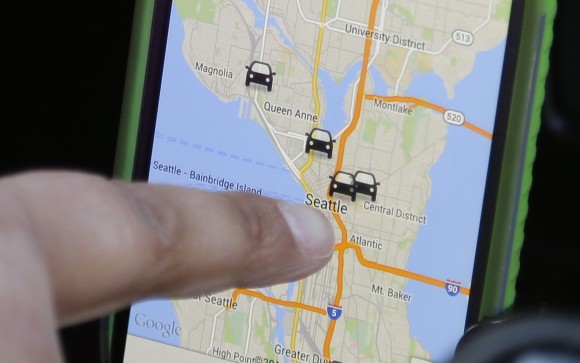This question of whether an Uber driver is an employee doesn’t matter just to Uber.
As you may have heard, the on-demand car-service juggernaut lost a case early this month before the California Labor Commissioner on whether a driver was an independent contractor or an employee, and thus eligible for expense reimbursement. Uber is appealing that ruling in court, but it already faces a class-action lawsuit over the same issue in federal court in California and similar fights in Florida and Massachusetts.
These legal battles have actually become pretty common lately for car services and taxi companies, not just Uber. Sometimes the issue is that drivers who clearly are employees (they don’t own the cars, they only drive for one service) are treated as independent contractors by skinflint car-service owners. More often than not, though, it is cases like Uber’s, where drivers own their cars, can drive for other services and can set their own timetables — all attributes of an independent contractor — but are dependent on the service in ways that make them seem not quite independent.
It isn’t just car services, either. Drivers of larger vehicles are also frequent litigants in what are called “independent contractor misclassification” suits — FedEx settled one last week with 2,000 California pickup and delivery drivers for $228 million and has similar suits pending in other states. I asked Richard J. Reibstein, a New York-based partner at the law firm Pepper Hamilton who represents employers in such cases, to reel off some other industries in the crosshairs of plaintiffs’ attorneys and regulators. His list: “construction, janitorial, staffing, Internet services, landscaping, cable companies, security, health services, educational services, performing arts, publishing.”
In many of these disputes, there are reasonable arguments for both sides. In a March ruling that a class-action lawsuit against Uber rival Lyft should go to trial, for example, U.S. District Court Judge Vince Chhabria wrote:
“At first glance, Lyft drivers don’t seem much like employees. … But Lyft drivers don’t seem much like independent contractors either.”
This quandary isn’t a new one. Here’s Supreme Court Justice Wiley Blount Rutledge in 1944:
“Few problems in the law have given greater variety of application and conflict in results than the cases arising in the borderland between what is clearly an employer-employee relationship and what is clearly one of independent entrepreneurial dealing.”
This was in the majority opinion in National Labor Relations Board v. Hearst Publications, in which the court backed up an NLRB decision that, for the purposes of collective bargaining, newsboys who delivered or sold newspapers should be classed as employees. Three years later Senator Robert Taft tried to make it clear with the Taft-Hartley Act that no, they were independent contractors. But he didn’t make it quite clear enough — newspaper publishers are still losing lawsuits to news carriers who say they were misclassified as independent contractors.
Along the way, the focus has shifted from collective bargaining to benefits and worker protections. Only 6.6 percent of U.S. private-sector workers were union members in 2014 — down from 24.2 percent in 1973. But those classed as employees now enjoy a wide variety of federal, state and local protections, from minimum-wage and overtime laws to unemployment insurance, that aren’t available to independent contractors. Most of the lawsuits and regulatory enforcement actions, then, are about wages, expenses and benefits that workers would have gotten had they been treated as employees rather than contractors.
While legal wrangling over these matters is, as noted, not at all new, Reibstein said it has really heated up during the past six years. That’s partly because the Obama administration has been much more interested in the subject than the Bush administration was. But it’s also because such semi-independent work arrangements seem to be on the rise, and are definitely getting new prominence as fast-growing companies such as Uber, Lyft, Airbnb, TaskRabbit and Upwork make them central to their business plans.
The great forerunner of all these companies is online marketplace eBay, and its experiences illustrate some of the issues at work here. “Employee” doesn’t seem at all the right term for those who sell their wares on eBay — infrequent sellers are equivalent to somebody holding a yard sale; “PowerSellers” are simply merchants. Yet eBay sellers are dependent on the company’s platform and the rules it sets in ways that a yard-seller or a Main Street merchant are not. The result: lots of class-action lawsuits about the terms eBay imposes on sellers.
Still, eBay is at least at no real risk of having its sellers deemed employees. Reibstein says Uber could lessen its legal risk a lot “by exercising less direction and control” over its drivers. But that could make it harder for the company to offer its customers reliable service. The employer/contractor legal dichotomy might push Uber and its peers in directions that economic logic and general good sense would not.
“The dichotomy makes the provider-platform relationship more adversarial than it needs to be, which hurts platform culture,” Arun Sundararajan, a New York University professor who has done much research on what is often called the “sharing economy,” said in an e-mail when I asked him about this. “It introduces an artificial distance.” Sundararajan has in the past contrasted Uber’s less-than-cozy relationship with its drivers with the culture at lodging marketplace Airbnb. In his e-mail he continued:
With Airbnb, there’s little or no risk of a host being considered an employee, so the platform has more freedom to bring the providers “closer” and engage in interaction with their hosts that might be associated with a firm-employee relationship in a traditional company. I believe many of the platforms would give their providers more (if for no other reason, as a retention and brand-building strategy) if the risk of “might be considered an employee” were lower.
One possibility that Sundararajan suggested in a Financial Times op-ed this week would be to decouple the employee safety net of health coverage, workers’ compensation and the like from full-time employment. Another that’s been getting renewed attention lately would be to add a new legal class of worker somewhere between the employee and the independent contractor — the “dependent contractor.” The term was introduced to North America in a 1965 law review article by Canadian scholar H.W. Arthurs, who said he got it from a 1962 book on Swedish labor relations, and Canada, Sweden and Germany are among the countries that have long had such a classification.
In Arthurs’ account the distinction was, as with the newsboys of the 1940s, all about allowing dependent contractors to organize for the purpose of collective bargaining. That’s clearly one big issue. When it comes to what other benefits of employee-dom dependent contractors should enjoy, things would presumably get very complicated very quickly. Also, because there is pretty much zero chance that the current Congress will address this issue, advances are more likely to come state by state. That’s good in the sense that it will allow room for experimentation and comparison — but it may prove maddening to companies operating in multiple states.
Still, acknowledging that the current classifications aren’t enough seems like it would be a big step forward. “The jury in this case will be handed a square peg and asked to choose between two round holes,” wrote Vince Chhabria, the judge in the Lyft case. Time to start carving out some square holes.
Related
- Individual or Corporate? Two Visions of the Sharing Economy
- How On-Demand Economy Is Changing Workers’ Compensation
- Google Targeted in Independent Contractor Classification Dispute
- Uber Expected to Ride Out Employee Ruling, Maintain High Valuation
- How Ruling That Drivers Are Employees Upends Uber Business Model
- States Going After Employers Who Misclassify Workers as Independent Contractors
- Home-Sharing Service Airbnb Offers $1M Host Liability Policy
Was this article valuable?
Here are more articles you may enjoy.



 As E&S Market Growth Hits New Heights, Some Risk May Be There to Stay: AM Best
As E&S Market Growth Hits New Heights, Some Risk May Be There to Stay: AM Best  Report: Over 250,000 US Properties Have Repeated NFIP Claims
Report: Over 250,000 US Properties Have Repeated NFIP Claims  Cards Against Humanity Sues Elon Musk’s SpaceX Over Alleged Trespassing in Texas
Cards Against Humanity Sues Elon Musk’s SpaceX Over Alleged Trespassing in Texas  7 in 10 Actuaries and Underwriters Worry About Being Replaced by AI
7 in 10 Actuaries and Underwriters Worry About Being Replaced by AI 

